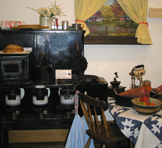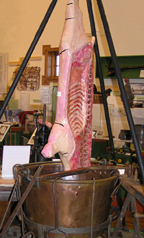2009 EXHIBIT:
Early Days on the Farm
The Beaver Area Heritage Museum’s 2009 exhibit, “Early Days on the Farm,” celebrates a lifestyle virtually lost to today’ factory farms. The display, which will run from March through December, depicts the lifestyle, equipment and values of local farms in the 1940s.
 Visitors will enjoy a rare opportunity to view a varied, impressive lot of artifacts that provide a vivid picture of farm life during the World War II era. Outdoor activities will take place throughout the year to augment the exhibit.
Visitors will enjoy a rare opportunity to view a varied, impressive lot of artifacts that provide a vivid picture of farm life during the World War II era. Outdoor activities will take place throughout the year to augment the exhibit.
An aerial map of present-day Brighton Township — provided by the Daniel C. Baker Associates, Inc., engineering firm — provides local historical context, identifying 1940s farms by location, with corresponding photos. In addition, the exhibit showcases historic photos of farms on what is now Heritage Valley Medical Center and Friendship Ridge property, as well as photos and information about cattle rancher Harriet Ward, the only female farmer in Pennsylvania in her day.
The exhibit contains a comprehensive assortment of farming tools, including a plow with horse collar and bridle, a cobblers’ bench, and a grinding wheel (for sharpening knives and tools). Also shown are barn building tools, cattle tools (including branding irons, and special metal-studded halters for use in weaning calves from cows) and hay-making and metalworking tools.
 |
 Exhibit curator John McLaughlin points out that all of the farm work was done by hand — machines did not come into widespread use in farming until after the war. Most farming tools are starkly utilitarian in nature and style. The exception is a ceramic field jug, decorated with vines, used to bring refreshment to field workers. The jug’s original owner, Hugh McLaughlin, a well driller, used to tell stories about carrying a jug of tea spiked with brandy to re-energize workers near the end of their long workday.
Exhibit curator John McLaughlin points out that all of the farm work was done by hand — machines did not come into widespread use in farming until after the war. Most farming tools are starkly utilitarian in nature and style. The exception is a ceramic field jug, decorated with vines, used to bring refreshment to field workers. The jug’s original owner, Hugh McLaughlin, a well driller, used to tell stories about carrying a jug of tea spiked with brandy to re-energize workers near the end of their long workday.
 The most visible item in the exhibit conveys the importance of pork as the primary meat source on early American farms: Hogs were cheaper and easier to raise than other animals, and could be processed with minimal skill and equipment. The display contains most of the equipment needed to feed, butcher and cure pigs — as well as a life-size replica (complete with parts labeled to show what cuts come from where).
The most visible item in the exhibit conveys the importance of pork as the primary meat source on early American farms: Hogs were cheaper and easier to raise than other animals, and could be processed with minimal skill and equipment. The display contains most of the equipment needed to feed, butcher and cure pigs — as well as a life-size replica (complete with parts labeled to show what cuts come from where).
Another aspect of farm craftsmanship and beauty is the period quilt display and a replica of a cozy farm kitchen, complete with a kerosene stove of the type still used by the Amish today. The kitchen table is replete with period food and kitchen items. Additional items on display include a complete set of implements and instructions for making sauerkraut.
Also featured are elements of the life of early farm children: antique metal toys, quilt patch animals and a child’s embroidery and “fancywork” from the 1940s. Not to be missed, a colorful wildlife display underscores the importance of hunting to early farm life.
— text and photos by Paula Soto